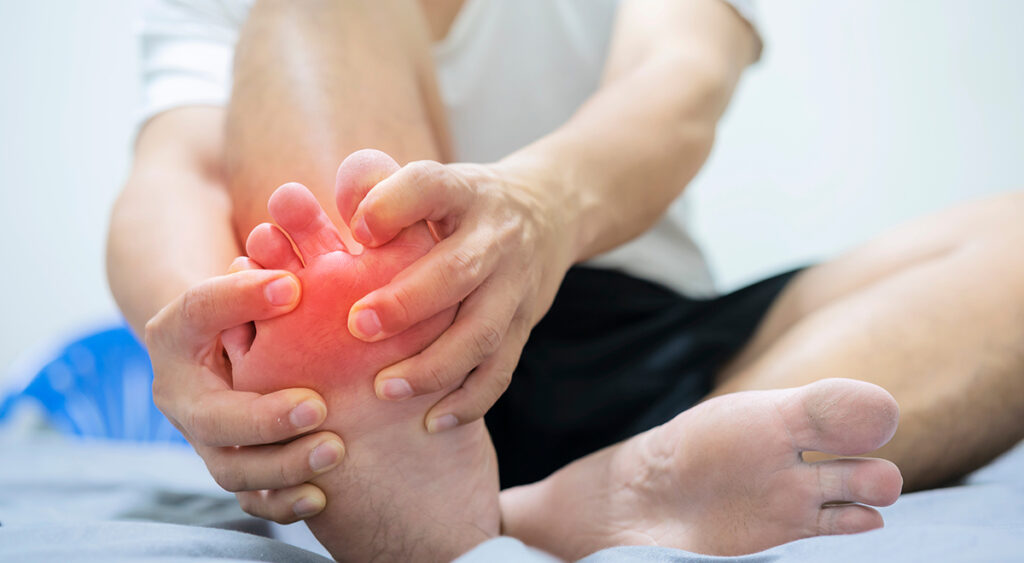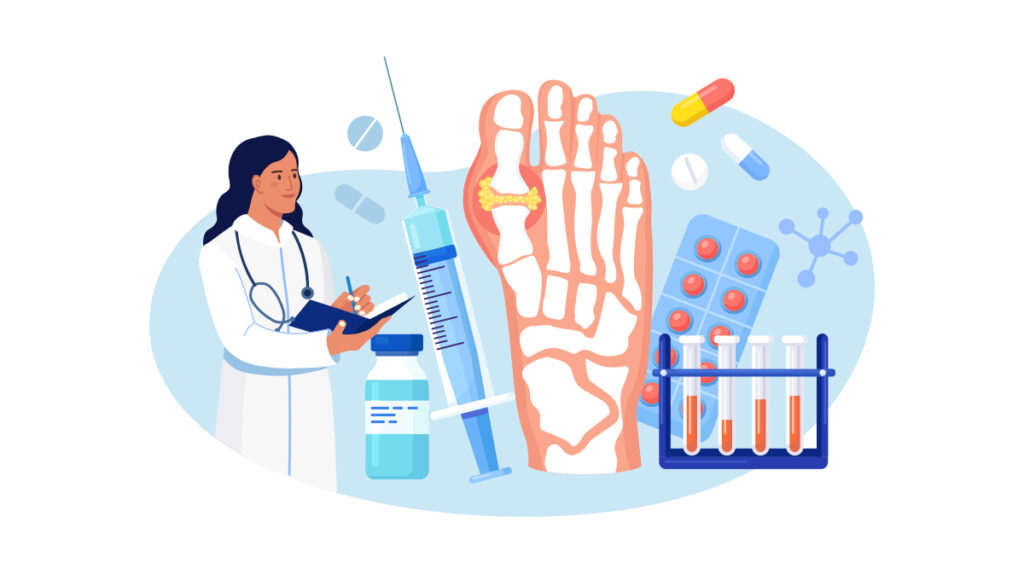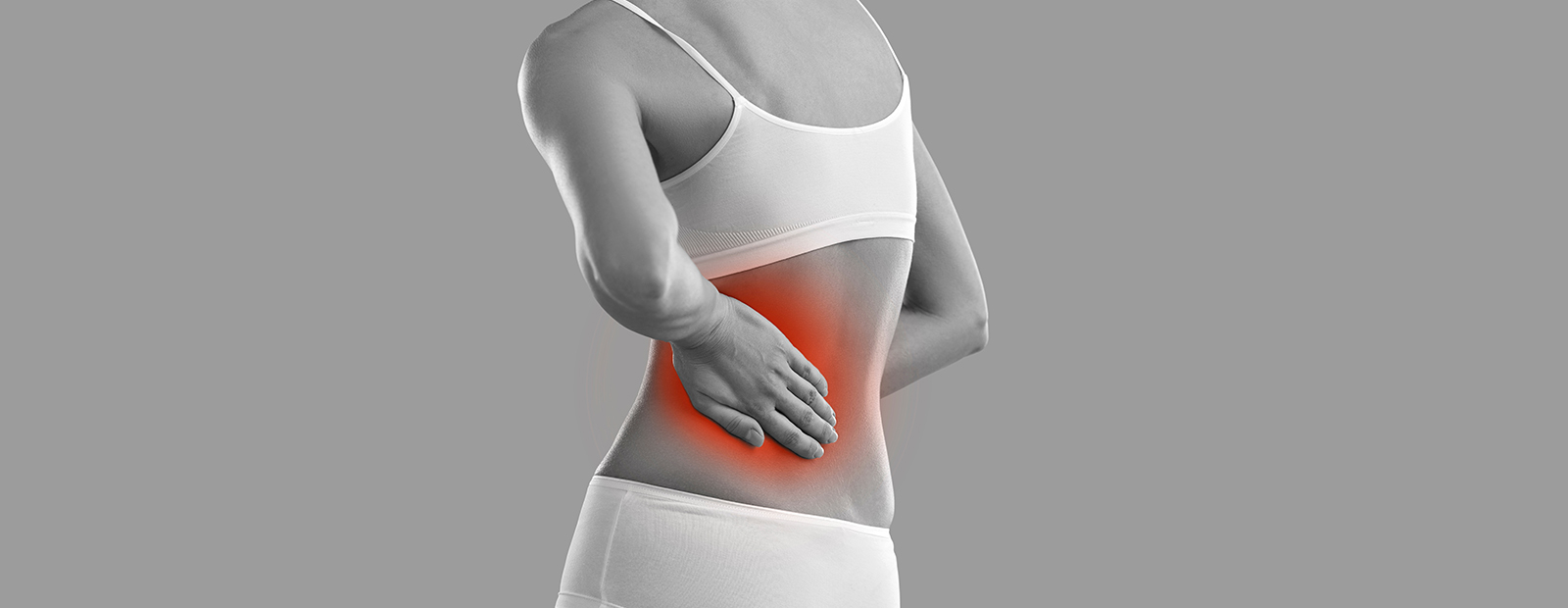How does joint arthritis affect different joints?
Joint arthritis is a painful condition that affects a surprisingly big part of our adult population.
It comes with symptoms that can severely hinder our everyday lives, like joint pain, stiffness, and decreased range of motion.
Stay with us to learn more about how arthritis can affect different joints and what you can do about it.
Different forms of arthritis and our joints
The term arthritis itself refers to a group of diseases that causes joint inflammation and pain.
So, technically, every form of arthritis is joint arthritis. But there are differences in the underlying causes, symptoms, and treatment options.
If you'd like to learn more about the most common types of the disease, you can do so in our overview article about arthritis. In this article, we will talk about how arthritis can affect different joints.
How arthritis affects different joints?
Most forms of joint arthritis can occur in any joint of the body. However, they usually affect only a few at a time, especially in their early stages.
Arthritis in the foot
Painful, swollen or red joints in the feet might be a sign of arthritis.
Gout is one of the most notable examples of foot arthritis, as it often starts in the big toe. Other forms of arthritis which might affect the feet are osteoarthritis, rheumatoid arthritis, or post-traumatic arthritis.
If you experience foot arthritis, the following things can help ease the symptoms:
- Wear special shoe inserts that decrease the stress on the joints
- Avoid high-impact exercises like running and soccer
- Use temperature therapy to reduce pain and stiffness, but avoid heat therapy if you have inflammatory arthritis
Knee arthritis
The knees are one of the joints most commonly affected by arthritis.
Osteoarthritis might often be the cause behind this. It's a degenerative joint disease that causes the joint tissues to break down over time. Post-traumatic arthritis might also be at play, as it is a form of osteoarthritis triggered by joint trauma.
Here are a few tips on how to make life with knee arthritis easier:
- Avoid further stress and trauma to the joint
- Reduce the load on the damaged joints by maintaining a healthy weight
- Stabilize the joint with wrap bandages, braces, or walking canes
Hip arthritis
If you experience pain, weakness, and cracking sounds in your hip area, these might be the signs of hip arthritis.
Because the hips are weight-bearing joints, they have a higher risk of developing osteoarthritis. Rheumatoid arthritis, psoriatic arthritis, and avascular necrosis can also affect the hip area.
When dealing with hip arthritis, you might want to pay attention to these things:
- Avoid overuse and high-impact stress on the joints
- Try to change your office chair to an ergonomic one
- Stay physically active with low-impact sports like swimming
Spinal arthritis
Arthritis in the spine can cause back pain, inflammation, and stiffness. In severe cases, it might even limit your range of motion.
Rheumatoid arthritis and osteoarthritis are common forms of the disease that might affect the spine and the sacrum area. The symptoms usually appear in the neck or the lower back. If you experience back pain, it's crucial to see a doctor, because some conditions have a better prognosis with early treatment.
Try to apply the following everyday changes to reduce your back pain:
- Use an ergonomic mattress and office chair that offers better support for your spine
- Remain physically active
- Avoid sitting in one position for too long, and take small breaks when working in front of a computer
- Make sure your core muscles can support your spine by keeping them in good shape with low-impact exercises like tai chi or swimming
Arthritis in the shoulders and elbows
Arthritis in the elbows or shoulders is less common than in other joints, but it can still occur.
Both osteoarthritis and rheumatoid arthritis could affect these joints, but psoriatic arthritis and gout are also possible causes, especially in the elbow. While they are not categorized as arthritides, frozen shoulder and bursitis could also cause similar symptoms in the shoulder area.
If you experience pain, stiffness, and swelling, following these simple steps might help ease your symptoms:
- Avoid repetitive movements, high-impact stress, and overuse of the joint
- If you are doing office work, try to find a more comfortable position for your arms or use an ergonomic mouse
- Braces and wrap bandages can help stabilize the joint and reduce further stress
- Avoid lifting heavy weights
Arthritis in hands and fingers
The fingers and the wrist are often affected by arthritis.
Psoriatic arthritis, rheumatoid arthritis, lupus, osteoarthritis, and gout are different forms of arthritis that might appear in the joints of the hand. They might cause pain, swelling, stiffness, or in more severe cases, even bone deformities.
This form of arthritis can be especially uncomfortable because we use our hands for so many things. When dealing with arthritis of the hands, even simple everyday tasks can turn into painful challenges.
There are a few things that might make it easier to manage your symptoms:
- Try to avoid strong gripping movements and overuse of the joints
- If you work in an office setting, try to use an ergonomic mouse
- Try to utilize technologies like voice commands and speech-to-text tools to minimize the stress on your hands
Polyarthritis
Sometimes arthritis only affects one single joint, but more often than not, it appears in multiple joints simultaneously. Rheumatoid arthritis is well known for this because it's a systematic autoimmune disease that affects the whole immune system, and the symptoms often appear symmetrically on both sides of the body.
When some form of arthritis affects more than five joints, we call it polyarthritis.
It's important to note that it's also possible to have multiple different kinds of arthritis in parallel.
Treatment options for joint arthritis
Regardless of which joints arthritis appears in, it's best to look for treatment options as soon as possible. For many forms of arthritis, an early diagnosis can make treatment more effective.
Different types of arthritis have different underlying causes and symptoms. Because of this, treatment options may also vary. Most kinds of joint arthritis are incurable, so usually, the goal is to minimize the impact of symptoms and slow down further progression of the disease.
Medications, physical therapy, alternative pain management methods, and surgery can all be part of the treatment plan. If you'd like to know more about your treatment options, see our article about remedies for arthritis.
How to Focus Better: 19 Activities for Improved Concentration
One of the most prevalent complaints of modern lifestyles is a lack of concentration and focus in adults. As the world we live in grows more complex, so do our work and home life demands, and it has arguably never been more important to boost mind power. Yet, ironically, levels of concentration are at an all-time low. Individuals are concerned more than ever with how to focus better.
Concentration refers to the control of attention: the mental effort directed towards a certain task or activity. In addition to this, it refers to the exclusion of attention to any other subject matter apart from the task at hand.
One’s ability to concentrate may vary person to person for a number of reasons, such as age, lack of sleep or stress levels, or simply the ability to tune out distractions. Cognitive issues such as head injuries or concussions, as well as a handful of mental health conditions can also affect mind power and contribute to impaired concentration.
If you are wondering how to focus better, here are a number of strategies to consider.
Follow Your Focus Better
We all have a time of day where productivity is at its highest – and that time is different for everyone. You may find yourself reading the same passage of a book a few times over, or battling to concentrate during a morning meeting. If you want to understand how to focus better, start by making a mental note of concentration peaks and dips during the day, then try to structure tasks or activities that require focus around them.
Create a Focus-Friendly Environment
The ability to focus for extended lengths of time requires a supportive environment. While not all work environments are within our control, make adjustments where possible when addressing how to improve concentration and focus. Make sure your seat is comfortable, your back has ergonomic support to avoid slouching, your desk is at the right height and the lighting is appropriate to keep your eyes from straining. If possible, control the temperature to be moderately cool, and have water nearby so you don’t need to get up often. Continually working from the same spot can also be an effective strategy on how to focus better – conditioning your brain to switch into concentration gear whenever you return to that space.
Be Sensitive to Sound
Reduce distracting or particularly loud noises as best you can. Consider playing muted instrumental music or even ambient nature sounds (there is an abundance of playlists on platforms such as YouTube) to drown out background noise and help create a consistent environment that your mind associates with concentration. When considering how to improve concentration and focus, the general rule of thumb is to not play music that you particularly like or dislike, as you may find yourself tuning into the song rather than the task at hand.
Take a Tech Break
Notifications on our many electronic devices contribute to a lack of concentration and focus in adults, thanks to the sporadic and ongoing distractions they create. Consider putting your smartphone into airplane mode, or turning off email and app notifications while you are attempting to focus on a particular task. The same goes for your laptop or monitor: if you are implementing strategies on how to focus better, work offline to prevent on-screen notifications from pulling your attention. To better improve these effects, consider placing devices such as your smartphone out of eyesight while they are not needed.
Set a Social Media Limit
Along with tech restrictions, limiting your social media use can go a long way when addressing how to improve concentration and focus. The reward mechanism in the brain is activated when we engage with social media, which encourages us to use it more often. Smart phones allow you to set limits on your social media interaction, which can be helpful in restricting your use, particularly in the work day. Designating time to look through social media versus having access to it at any time can also help you to stay on task if you are exploring how to focus better.
Make a To-Do List
Not having a clear idea on what needs to be done next can contribute to a lack of concentration and focus in adults. Write down a to-do list of what you would like to achieve in the day, preferably the night before. Creating a reasonable to-do list not only helps you to prioritize what tasks need to be completed first, it can also help you keep track of incomplete errands that are weighing on your mind. Prioritizing helps relieve the mind of distracting anxiety, while accomplishing small tasks daily can wire the brain for success.
Feed Your Brain
It comes as no surprise that the fuel you put into your body influences the output. If you are exploring how to improve concentration and focus through diet, boost mind power by including more of the following foods into your daily nutrition: fatty fish (such as salmon and trout), eggs, berries and dark leafy greens, along with plenty of water – even mild dehydration can make it harder to focus or remember information. Breakfast meals that are low in sugar and high in protein and fiber will also sustain your energy levels throughout the day: examples include oats, yoghurt and fruit or whole-grain toast with eggs.
Supplement with Micronutrients
Micronutrients – vitamins, minerals and antioxidants – are an essential component of wellbeing and cognitive function, yet even the healthiest of diets don’t always manage to include the diversity of nutrients needed for excellent health. Supplementation helps us to pick up the nutritional slack by supplying essential micronutrients that we would battle to take in through food alone. Specific micronutrients thought to support cognitive function include omega-3s, resveratrol, ginkgo biloba and B vitamins.
Get Moving
Physical activity should form part of any strategy on how to focus better. Improved concentration is among the extensive benefits of exercising regularly. Exercise can enhance both attention and concentration within as little as four weeks, thanks to its ability to boost the brain’s dopamine, norepinephrine and serotonin levels. Memory loss that occurs with age-related brain atrophy may also be stopped or even reversed after a year of moderate physical activity. In particular, exercising before or between periods of focus has proven to be the most beneficial for concentration.
Train Your Brain
Playing certain games can support better concentration by sharpening your focus. These could include Sudokus, crossword puzzles, chess, word searches, jigsaw puzzles and memory games. These will also not only improve concentration, but working and short-term memory as well, along with processing and problem-solving skills. These types of games have a positive effect on children who are struggling with concentration, and are particularly important for older adults, since concentration and memory tend to decline with age.
Play Video Games
While children and adults are discouraged from overuse of video games, a limited time spent playing digital action games may prove helpful in certain levels of concentration. Individuals may be able to track multiple objects at the same time, switch tasks more effectively and even improve reading speeds.
Try a Concentration Workout
In line with using games to increase concentration, there are specific activities you can undertake if you want to learn how to focus better. The idea is to fully immerse yourself in a specific activity for a set period of time to encourage the ability to concentrate. Relevant activities could include spending a few minutes throwing a ball back and forth between you and another person, drawing or doodling for a few minutes, or reading a short story. Afterwards, reflect on how often you lost focus and needed to reassign your attention to the task at hand.
Get Quality Sleep
If you find yourself choosing between extra time focusing on a task or activity and a good night’s sleep, go with the latter. It may seem counterproductive, but when you’re well rested your performance improves. The occasional late night won’t have any major effects on your concentration, but regularly falling short on sleep will negatively affect your concentration (as well as your mood, emotions and general cognitive abilities).
Quality of sleep is as important as quantity when considering how to focus better; try stick to a sleep routine to cue your body for bed, keep the room cool and aim for a consistent bedtime.
Our electronic devices are amongst the biggest culprits when it comes to disrupting sleep. They usually emit blue light that stimulates the eyes much like daylight, preventing the secretion of the sleep hormone, melatonin. Use a filter or glasses that block blue light to minimize exposure, or try avoid electronic devices at least an hour before bed. Also avoid exercising too late in the day, which can keep the metabolism fired up and resistant to sleep.
Practice Mindfulness and Meditation
Mindfulness and meditation helps us rewire the brain to find better, more efficient ways to handle tasks – and therefore improve concentration. Practicing mindfulness includes deep breathing, meditation to improve focus, doing yoga or taking time to fully concentrate your attention on one item as you observe and savor it – this could be an object, a piece of music or art or even your next meal.
Meditating in particular helps the whole body to relax and the brain to become calmer; the focus on breath encourages resistance to mental distractions. With practice, it is possible to use the breath to bring the attention back to the task at hand, encouraging concentration even when interrupted.
Spend Time in Nature
If you are exploring how to improve concentration and focus naturally, consider spending more time outdoors. Getting outside each day, even for a brief amount of time, is thought to supply focus-boosting benefits, as well as generally support your physical and mental wellbeing. This could include a short walk through a park, sitting in your garden, or spending a few minutes in the sunshine with your eyes closed.
If you are unable to get outside, including plants in your working spaces may help boost mind power and productivity too. This also contributes to air quality and workplace satisfaction, which may indirectly improve your focus.
Don’t Multitask
While you may feel productive bouncing between tasks, the opposite is usually true. The brain is not designed to cope with doing more than one thing at a time, and trying to juggle activities simultaneously may mean you perform worse on each task overall.
Multitasking is not the same, however, as task switching, which may prove to be helpful when considering how to focus better. If you are stuck on a particular activity and your brain needs something fresh to focus on, switching tasks may help revive your mind power and promote you staying productive for longer.
Time blocking may also help you achieve working on a single task before moving on to the next one. Assigning time to certain activities allows you the mental space to ignore distractions, knowing that time has been allotted to address those at a later stage. Making a rule to complete any task that comes to mind immediately, provided it takes less than five minutes, is another simple strategy for how to focus better and help stop small distractions piling up.
Take a Time Out
If you are considering how to focus better on a lengthier task, you may benefit from taking breaks more often. This has less to do with improving your concentration and more to do with the renewal of focus. Given that concentration spans are short, it may serve you better to take short breaks between 15-minute slots of intense focus than to push through for a consecutive 30 minutes.
Address Your Mental Health
While there are a wealth of external stimuli that may disrupt concentration, there may be internal factors affecting your mind power too. If you are exploring how to increase concentration and focus but finding little success, you may need to turn inwards.
Underlying mental or physical health conditions can contribute to a lack of focus, such as ADHD, which is characterized by a persistent pattern of hyperactivity, inattention and impulsivity. Untreated mental health conditions such as depression or anxiety typically present with emotional symptoms, but can indirectly affect concentration and memory as well. Certain medications and their side-effects may contribute to impaired cognitive function, and alcohol consumption can influence your ability to think clearly.
Support Your Eyes
Sometimes farsightedness or other vision problems may contribute to concentration issues. Notice if you are struggling to focus when using certain visual stimuli and consider having your eyes checked if you recognize ongoing issues. Resting your eyes during periods of intense concentration is a helpful strategy when considering how to focus better. Just as other muscles in the body can become achy and stiff, your eyes can become tired when only focusing on one object. Give them a break by using the popular 20-20-20 rule: staring at an object 20 feet away for a total of 20 seconds, every 20 minutes. If you are looking for a 100% natural and drug-free strategy to enhance concentration and focus, explore Super Patch’s Flow Patch. The Flow Patch recruits vibrotactile technology, sending a unique neural signal to the brain to help improve your concentration, memory and endurance.
Hand joint pains – Causes, diagnosis, and treatments
There are very few things in our everyday lives that don't require the use of our hands. No wonder hand joint pains are among the most disrupting experiences.
Understanding the symptoms, underlying causes, and treatment options can help you manage your hand pain and return to your pain-free life.
Understanding joints of the hand and their functions
The human hand is a complex structure of bones, joints, and tissues allowing us to make delicate movements, act with incredible precision, and perform various tasks. Some scientists even believe that our opposable thumbs made it possible for humans to evolve such complex brains and develop what we know as culture.
There are a total of 27 bones in the wrist and hand, connected by numerous joints, and more than 30 muscles to control it.
As such a delicate structure, used for everyday tasks, hands are especially prone to injury and damage from overuse, and many joint diseases might affect them.
Joint pain in the hands can disrupt this well-oiled operation, cause discomfort and make our life significantly harder.
Causes of hand joint pain
With so many moving parts, pain in the wrist and hand might stem from many different conditions. Below, we'll discuss some of the most common ones and their symptoms.
Injury
We use our hands for many daily tasks, which puts them at a higher risk of injury. Accidents and falls can damage the joints or structure of our hands, but even simple things such as overuse can lead to hand injuries.
Depending on the severity of the injury, it might simply heal with rest, or we'll need to see a doctor for treatment. In some severe cases, surgery might be necessary.
Arthritis
Arthritis is a term that refers to many different joint conditions, all of which might cause joint pain and inflammation. Most of these conditions are incurable, chronic diseases, so the focus of treatment is usually reducing the everyday impact of symptoms. Arthritis in the hands is a common form of the disease.
Osteoarthritis and rheumatoid arthritis are the most common types, both of which might affect the joints of the hand.
Gout is a form of arthritis that causes sharp pain attacks and might appear in the hand joints.
Carpal tunnel syndrome
The carpal tunnel is a narrow passage at the base of our hand and forearm. Its function is to protect the median nerve and tendons of the forearm.
Due to overuse, inflammation, or other underlying issues, the carpal tunnel might get too narrow, which might apply pressure to the median nerve. This can lead to numbness, pain, and tingling in the hands or the forearm.
Tendinitis
Tendons are tissues that attach our muscles to the bones. Tendinitis occurs when these tissues get inflamed, often due to overuse, repetitive movements, or overstretching.
Tendinitis is a common underlying cause of hand pain because of how much use they see.
De Quervain's tenosynovitis
De Quervain's tenosynovitis (also referred to as tendinitis or tendinosis) is a condition that affects the tendons alongside the wrist and thumb.
These tendons get swollen due to irritation or the narrowing of the tendon sheath, leading to
stiffness and joint pain in the thumb and the side of the wrist and sometimes affecting the forearm too.
De Quervain's tendinosis is more common among women, and pregnancy is a risk factor in developing the condition.
Trigger finger
Trigger finger, also known as stenosing tenosynovitis, is a condition affecting the tendons in the hand responsible for flexing the fingers.
When these tendons or their tendon sheaths get swollen or irritated, leading to pain and stiffness. The typical symptom of trigger finger is the locking or catching of the tendon, causing a popping sound when flexing the fingers.
Systemic conditions
In some cases, joint pain is not a standalone condition but only the symptom of an underlying issue. Some chronic diseases might affect the entire body, leading to various symptoms, including hand joint pains.
Fibromyalgia or the autoimmune disease lupus, for example.
Diagnosing hand joint pains
Hand and wrist pains are often the result of simple overuse. In these cases, resting the hand might solve the problem. But if the pain doesn't go away with rest, you'll need to consult a health care professional for diagnosis.
Doctors might use a combination of physical examination methods, imaging techniques, and body fluid tests to determine the source of pain and to identify possible underlying conditions.
Treatment options for hand joint pains
When it comes to joint pain in the wrist or hand, pain management is crucial. Not only it helps us keep performing everyday tasks, but in some cases hastens or makes the healing process more comfortable.
Below, we'll explore various pain management methods and techniques that could help you relieve hand and wrist pains.
Pain medications for hand joint pain
Traditional analgesics, like paracetamol, can ease acute hand pains from an injury or overuse. If the source of pain is inflammatory, then nonsteroidal anti-inflammatory drugs (NSAIDs) could provide effective relief.
For chronic conditions such as autoimmune conditions and arthritis, doctors might prescribe more potent drugs like disease-modifying antirheumatic drugs (DMARDs) or steroid injections.
Mechanical pain relief options
Besides traditional drugs, there are also some mechanical ways that might help relieve joint pain.
A physical therapist could teach you stretching exercises to loosen stiff joints, make your joints stronger and stabilize them. They can also help you with advice on modifying your everyday activities in a way that puts less stress on the painful joint.
Braces and bandages are simple but effective solutions to stabilize the joint and reduce stress and pain. Using ergonomic tools for everyday tasks, like typing, could not only help alleviate your existing joint problems but could also reduce the risk of future issues.
And let's not forget that resting the painful joint is oftentimes crucial for proper healing. Try to avoid repetitive movements and overuse as much as you can.
Alternative pain relief options
You might also want to look into other drug-free pain management methods. These can help you avoid the side effects of traditional medicines or even supplement them in your routine.
Heat and cold therapy is one effective and science-backed way to relieve pain without drugs.
Meditation can also help you reduce your body's reaction and sensitivity to pain signals while providing other benefits as well.
You could also try drug-free pain patches like our FDA-approved Freedom patch. With innovative vibrotactile technology, these patches reduce the pain signals right at the nerve level, providing non-invasive, safe, and drug-free pain relief.
Understanding Gout: Causes, Symptoms, and Treatments
Gout is a form of arthritis that causes pain and inflammation in the joints.
While there is no cure for gout, you can manage symptoms and slow down the progression of the disease to regain your normal life. To do this, you will need to understand the symptoms, causes, and treatment options.
Today we will talk about these and more!
What is gout?
Arthritis has many different forms, and gout is one of them. It’s an inflammatory disease caused by uric acid buildup in the body. This urate can form sharp little crystals in the joints resulting in pain flare-ups. At the same time, white blood cells will try to break down these crystals, producing toxic chemicals in the process, leading to inflammation and further discomfort.
While gout is incurable, it is possible to manage the progression and symptoms with certain medications and lifestyle changes.
Types and stages of gout

With gout, we can differentiate between primary and secondary gout. Primary gout is when the disease appears without any other underlying cause. Secondary gout, on the other hand, is usually either caused by some chronic kidney condition or might be a side effect of long-term medications.
Gout usually goes through different stages, progressively getting worse.
The first one is called asymptomatic hyperuricemia. As the name suggests, uric acid is already building up in the body, but the characteristic symptoms of gout are not apparent yet. At this stage, one has to focus on slowing down the further progression of the disease, usually by making some lifestyle changes.
The second stage of gout is called acute intermittent gout, where uric acid starts to form crystals in the joint, causing pain flare-ups. These attacks usually last for a few days at a time. During this stage, you may experience pain, swelling, stiffness, and redness around the joint.
The disease then progresses to an advanced stage called chronic tophaceous gout. By this time, the urate crystals might have already damaged the cartilage and bones in the joint. The pain might get worse and more frequent.
While it’s not a form of gout, we should also mention pseudogout. It has similar symptoms to gout, hence the name. The difference lies in the underlying issue, as the cause of gout is uric acid buildup, while pseudogout results from abnormal calcium pyrophosphate deposition.
Gout symptoms
Similar to most other types of arthritis, the main symptom of gout is joint pain. This pain usually comes in the form of sudden flare-ups that might last for days at a time.
Patients with gout might experience the following symptoms in the joint area:
- Intense pain
- Sensitivity to touch
- Red, shiny skin
- Swelling
- The joint feels hot
- Tenderness
- Occasionally fever
The pain flare-ups or gout attacks follow an unpredictable but very characteristic pattern. They often start at night and can get worse over the course of several hours. Depending on the stage and severity of the disease, attacks might last from a few days to a few weeks.
The frequency of the attacks is usually unpredictable, but they will occur more often and with stronger symptoms as the disease progresses to later stages.
Gout usually affects only one joint at first, often the big toe. But over time, you might experience similar symptoms in other joints too.
It’s crucial to keep an eye on your gout symptoms, as it is possible to have multiple forms of arthritis at the same time. For example, a high fever alongside the above symptoms might indicate septic arthritis resulting from an infection that needs immediate treatment.
Diagnosing gout
Gout’s telltale symptoms usually make it easier to diagnose.
However, it is paramount to rule out other forms of arthritis, as they can occur simultaneously. And we should not forget about pseudogout either, a similar disease but with a different underlying cause.
X-ray and ultrasound imaging tests can help visualize the uric acid crystals and rule out other possible causes of joint inflammation. While blood tests can reliably display high levels of uric acid in the bloodstream, this doesn’t necessarily lead to gout in every case. For this reason, joint fluid might be drawn and examined for urate crystals.
Doctors will also try to rule out kidney problems, as some of these can be an underlying cause of gout and lead to further problems.
An early diagnosis can help slow down the progression of the disease and better manage the symptoms. This can be achieved by lifestyle changes and often medication.
Gout causes
Purine is a substance that occurs in the body and different foods, such as certain kinds of seafood, some meats and organs, and some forms of alcohol. When the body breaks down purine, it produces uric acid, a natural waste product. Then the kidneys filter it from the bloodstream, and it leaves the body through the urine.
The problem arises when either there’s too much uric acid in the body, or the kidneys fail to get rid of it properly. These may cause high levels of urate in the bloodstream, called hyperuricemia.
In some cases, this urate buildup accumulates around the joints, forming sharp little crystals. That is what we call gout.
Certain factors can increase the risk of developing gout.
Purine, and therefore uric acid levels can be affected by our diet choices. Foods that cause gout are red meats, some kinds of seafood, fructose, and some alcoholic beverages like beer. Avoiding these can reduce risks and slow down the progression of already-developed gout.
Maintaining a healthy weight and exercising are very important with all sorts of arthritis as these will reduce the stress on the joints by putting less weight on them and strengthening the muscles in the surrounding areas.
Some medical conditions may also increase the risk of gout. Kidney conditions can affect the breakdown of uric acid in the body. Diabetes, high blood pressure, and some heart diseases may also increase the risk.
Other risk factors are beyond our control, like family history, age, and sex. Gout is more common and usually develops sooner in men. Gout in the family also increases your risk.
Gout treatment

When deciding on treatment options, it’s crucial to differentiate between primary and secondary gout. Secondary gout is caused by an underlying health issue, a kidney disease, for example. In this case, treating the underlying problem should be prioritized.
Regardless of the cause, slowing the progression and treating the symptoms are equally important. An early diagnosis can increase your chances of delaying the more severe stages of the disease.
The goal of gout treatment is usually twofold. We need to relieve the pain. And we need to lower uric acid levels in the body to slow down the progression of the disease.
Let’s look at the possible treatment options for gout.
Medication
For pain relief, doctors may prescribe different types of medicines, depending on the severity of the pain. In mild cases, analgesics or nonsteroidal anti-inflammatory drugs (NSAIDs) may be used. In more severe cases, corticosteroid or colchicine treatments might be recommended.
To lower uric acid levels, doctors can choose from a range of available medications, such as Allopurinol, Febuxostat, Pegloticase, Anakinra, or Canakinumab.
Lifestyle changes and diet
As with other forms of arthritis, staying active and maintaining a healthy weight can help slow down the progression of the disease.
One should follow a gout diet that reduces purine intake. It’s recommended to avoid the following foods as much as possible: high-fructose corn syrup, fatty meats, dairy products, organ meats, shellfish, anchovies, sardines, and alcoholic beverages.
Surgery
In severe cases, gout might cause irreversible damage to the joints. While surgery is a more drastic measure, doctors might advise it if a later stage of gout impacts the quality of your life severely.
It’s possible to surgically remove the uric acid crystals from around the joint. In cases of permanent damage, joint fusion or replacement surgery might be necessary.
Pain relief without the side effects
Pain is one of the major symptoms of gout. It affects your movement, your mood, and your everyday life.
Managing the pain flare-ups is not always easy. Painkillers and other medicines often come with undesired side effects, and alternative pain relief options are not always as effective.
Let me introduce to you our one and only Freedom SuperPatch! An effective pain management solution designed to be entirely drug-free, with no side effects. On its own or combined with other treatments, the Freedom pain patch will provide immediate gout pain relief during flare-ups.
Pain Management Techniques for Fibromyalgia Sufferers
Fibromyalgia is a chronic health condition that causes musculoskeletal pain and other symptoms.
Living with fibromyalgia can be a draining experience because it affects so many aspects of your life. It's a chronic condition with no known cure as of yet. So, the goal of treatment is to reduce its daily effects.
This article will help you better understand fibromyalgia by learning about the condition, its symptoms, and possible treatment options.
What is fibromyalgia?
Fibromyalgia is a medical condition that causes abnormal pain perception and widespread pain all across the body.
Research suggests that fibromyalgia amplifies pain signals, which might turn even simple everyday sensations into painful experiences.
Fibromyalgia often starts after some form of physical or emotional trauma. In some other cases, it develops slowly over time.
Fibromyalgia symptoms
Fibromyalgia often has a wide range of symptoms.
The most apparent one is body-wide musculoskeletal pain. It affects both sides of the body and areas above and below the waist. The pain usually occurs as a constant, dull sensation. But the condition may also cause periodic flare-ups where the pain becomes really intense.
General fatigue is a common symptom of fibromyalgia, as constant pain can disrupt sleep patterns and lead to tiredness.
Fibromyalgia often comes with a wide array of psychological symptoms as well. Fibro fog is one of these symptoms that makes it difficult to concentrate. Depression, anxiety, and other mental health problems are also common among fibromyalgia patients.
In addition to these symptoms, some adjacent diseases often appear alongside fibromyalgia. Irritable bowel syndrome (IBS), clinical depression, temporomandibular disorder (TMD), migraine, and painful bladder syndrome, to name a few.
Fibromyalgia causes and risk factors
While doctors don't know yet what causes fibromyalgia, certain risk factors might make it more likely to develop the condition.
Fibromyalgia might occur at any age, but people over 40 are more likely to develop the condition. The probability of developing fibromyalgia is twice as high for women than for men, but doctors need more research and data to identify the reasons behind this.
The condition often develops after severe physical or mental trauma, so scientists believe these events might also increase your risks.
Diagnosing fibromyalgia
Identifying fibromyalgia can be challenging because there are no direct tests for it, and symptoms may vary from person to person.
One constant symptom of the disease is widespread pain, where pain occurs on both sides of the body, both above and below the waistline. So doctors will likely ask you to self-assess your pain and explain your symptoms.
After that, they will use other methods, like bloodwork, MRI scans, and other tests, to rule out other possible causes and make the final diagnosis via differential diagnosis.
Fibromyalgia treatments
Fibromyalgia doesn't have a typical pattern. It's a dynamic condition where symptoms and the severity of pain might change periodically and will differ from person to person.
So, doctors usually try to adjust treatment options based on your own needs and experiences.
Below, we will list some treatment methods that are often used to ease the symptoms of fibromyalgia.
- Painkillers - Over-the-counter or prescription medications
- Physical therapy - Stretches and strengthening exercises
- Mental health therapy - Cognitive behavioral therapy, antidepressants, and stress management techniques
Living with fibromyalgia
Living with fibromyalgia can be a mentally draining experience. So, in addition to these treatment methods, it might also be helpful to set up a reliable support system and find self-care techniques that work well for you.
Pain management
Finding the right pain management methods is one of the most important things when it comes to living with fibromyalgia.
Drug-free pain patches, hot and cold therapy, and massages are all excellent ways to reduce your daily pain levels without the side effects of traditional painkillers.
Stay active
Keeping an active lifestyle not only helps your body to function better, but it may also be beneficial for your mental health. It might be hard to get moving when your body and mind feel drained, so it's best to choose some light exercises that are not too demanding.
Walking, swimming, water aerobics, or yoga are all excellent choices.
Stress management
Living with fibromyalgia can be a stressful experience. So it's crucial to take good care of your mental hygiene and to find healthy coping techniques.
Meditation is a safe and science-backed method to maintain mental hygiene, and it has the added benefit of lowering pain perception.
If your lifestyle allows for it, try to include blocks of downtime into your schedule.
Adjust your lifestyle and mindset
When you have fibromyalgia, you'll have to make some lifestyle changes to adjust to your condition. Practice self-compassion, and be patient with yourself.
Try to set up easy routines, habits, and failsafe methods to help you stay afloat when the inevitable pain flare-ups hit. And don't be afraid to reach out to your friends or family for help and emotional support when needed.
Keep a healthy lifestyle
Following a healthy diet, keeping active, drinking enough water, and avoiding drugs and alcohol can all go a long way when living with fibromyalgia.
Keeping a healthy lifestyle will allow your body and mind to better cope with the symptoms of your condition, and it decreases your risk of developing other adjacent diseases.
Chronic Back Pain: Definitions, Diagnosis & Risk Factors
The term “chronic back pain” is typically used to describe symptoms that appear gradually and persist beyond three to six months. Pain is also considered chronic when it continues beyond the point of tissue healing. For this reason, chronic back pain is usually correlated less with recognizable tissue damage and structural problems than acute pain.
Chronic back pain can develop anywhere between the top of the neck to the lower (lumbar) spine. Pain may exist only in a specific area, or it may generate from a central point and spread into other parts of the back and body.
Individuals experiencing back pain often avoid physical activity or compensate by moving their bodies in different ways. This can aggravate pain and symptoms, which has longer-term implications when pain is chronic.
Chronic back pain is typically age-related and is common in both men and women. While individuals may think a particular incident or injury is responsible for their symptoms, there are usually several contributing factors. This type of pain is, however, harder to diagnose than acute pain and an identified cause can’t always be found.
Identifying Chronic Back Pain
Longer lasting back pain can typically fall into two major categories:
Chronic pain with an identifiable cause:
This includes traumatic injury such as strains, sprains, disc herniation and fractures, as well as structural spine conditions such as spinal stenosis, degenerative disc disease and spondylolisthesis. Chronic lower back pain causes may also be the result of other medical ailments, including osteoporosis and fibromyalgia, rarer incidences of infections or tumors, as well as women-specific conditions such as endometriosis and ovarian cysts. These issues may cause ongoing pain until properly treated. While this is often classed as chronic back pain, it is also referred to as long-term acute pain.
Chronic pain without an identifiable cause:
If pain continues after damaged tissue has healed, or there is no identifiable reason for the pain, it can be classified as chronic benign pain. Sometimes, the nervous system may continue to send pain signals to the brain even when any damage to tissues has been healed and there are no remaining chronic lower back pain causes. These signal misfires may create an ongoing experience of chronic back pain despite there being no existing injury or problem in the body. Super Patch’s range of pain management patches address pain symptoms from this perspective.
Risk Factors
An ongoing lack of physical activity can lead to one of the biggest contributors towards chronic back pain: muscle deconditioning. Also known as muscle atrophy, this is where back muscles lose the strength and stability needed to support you, causing them to shrink and resulting in wear and tear over time. Some atrophy happens naturally as we age, but a general lack of physical activity, or reducing activity for too long after an injury can aggravate pain symptoms.
People who work at jobs that are sedentary, require heavy or repetitive lifting, or subject them to vibration from machinery or vehicles are more susceptible to developing chronic lower back pain. Driving a vehicle for a long time can also increase risk.
Improper posture and body mechanics during everyday life are common chronic lower back pain causes, as they can stress your spine and contribute to pain symptoms over time. Not correctly lifting heavy items, lack of ergonomic support if you sit at a desk for extended periods of time, and forgetting to stretch regularly during long patches of inactivity may put you at risk of chronic back pain.
Conclusion
Since it can be difficult to identify the source of chronic back pain, it is important to move cautiously with a treatment plan. If your doctor has exhausted diagnostic options, it may be time to visit a back pain specialist. If the source of pain remains unknown or the pain cannot be treated, a medical professional may help you to reduce flare-ups and manage the pain with nonsurgical relief options.
What Causes Chest Bone Pain?
The chest bone, known as the sternum or breastbone, connects the two sides of your rib cage together. It protects the many major organs in the chest and gut that sit behind it, including the hearts, lungs and stomach. This proximity to vital organs means that chest bone pain may be the result of many conditions that have little to do with the sternum itself. For this reason, the cause of a sore sternum may be hard to pinpoint.
Is My Chest Bone Pain a Heart Attack?
The first reaction to chest bone pain – especially acute or persistent pain – is to think it is a heart attack. But in many instances, chest bone pain has nothing to do with the heart, and is more likely caused by issues with the bones, muscles or digestive tract. This is particularly true in those who are under 40 and don’t have any underlying health conditions.
Conditions that May Cause Chest Bone Pain
Costochondritis
Costochondritis is a condition that is often responsible for a sore sternum and regularly mistaken for a heart attack or other heart condition. It is not, however, a serious condition, and occurs when the cartilage connecting the ribs to the sternum becomes inflamed. Symptoms may include sharp pains or aches to the side of the sternum, or pain or discomfort in one or more of the ribs. Pain may intensify when coughing, breathing deeply or moving the upper body. Costochondritis, also referred to as chest wall pain syndrome, costosternal syndrome or costosternal chondrodynia, cannot always be linked to a specific cause, but it is most likely the result of strain from physical activity, a chest injury, or joint conditions such as osteoarthritis.
Sternoclavicular Arthritis
Osteoarthritis involves the breaking down of joint cartilage over time due to wear and tear. The sternoclavicular joint (SC joint) connects the top of the sternum to the clavicle, and this hardworking joint may become painful if affected by osteoarthritis. Chest bone pain may be experienced at the top of the sternum, pain may worsen with activity or radiate into the arms, and swelling and tenderness may be present as well.
Traumatic Injury
Fracturing the sternum can induce intense pain and is usually the result of blunt force injury to the chest. It may be painful to breathe in or cough, swelling, pops and grinding noises may be experienced with arm movement, and there may be stiffness in the joint and shoulder. A sore sternum caused by injury to the SC joint or clavicle (collarbone) trauma will likely be accompanied by similar symptoms.
Muscle Strain
Pulling or straining a muscle in the chest wall through repetitive movement, increased activity level or a sudden, improper movement can result in chest bone pain. This may also occur during an illness that induces severe coughing or vomiting. Pain may be sharp or achy, worsen with movement, or be accompanied by muscle spasms or bruising and tenderness.
Hernia
Hernias occur when an organ pushes or pulls from the area where it normally sits. The most common form is a hiatal hernia, where the stomach moves into the chest cavity, past the diaphragm. In addition to a sore sternum, symptoms of a hiatal hernia may include heartburn, gas, trouble swallowing and fullness, amongst others.
Heartburn and Acid Reflux
Conditions that affect the esophagus, stomach and intestines may contribute to chest bone pain. Heart burn is a passing burning sensation in the throat, chest or abdomen caused by stomach acid. When this happens frequently, it can be a sign of acid reflux, where the lining of the esophagus begins to wear away from ongoing stomach acid. Both heart burn and acid reflux are common gastrointestinal causes for chest bone pain.
Stomach Ulcer
A stomach ulcer (peptic ulcer) refers to an open sore on the lining of the stomach or bottom of the esophagus. In addition to stomach pain on an empty stomach and other symptoms, chest bone pain may be experienced.
Respiratory Issues
Conditions affecting the respiratory system such as pleurisy (inflamed tissue around the lungs), pneumonia (lung infection) and bronchitis (inflamed bronchial tubes) may also contribute to a sore sternum and accompanying symptoms in the chest area.
Panic Attack
A sudden onset of irrational fear or panic is referred to as a panic attack. Often a result of stress or a symptom of mental health conditions, panic attacks may be accompanied by chest bone pain that may be mistaken for a heart attack.
Heart Attack
A heart attack refers to a blockage in an artery of the heart, preventing blood and oxygen from reaching that area. Chest bone pain is a common symptom of a heart attack, specifically chest pain in the middle or left side of the chest. Accompanying symptoms may include pain or discomfort in other areas of the upper body, including arms, shoulders and jaw, feeling dizzy or lightheaded, trouble breathing, sweating and nausea. A heart attack is life-threatening and requires emergency medical attention. In some instances of chest bone pain, over-the-counter medication or a change in diet may be enough to ease symptoms. But long-term treatment may be needed if there is a more serious underlying condition. Seeking out a doctor’s diagnosis for your chest bone pain will better help you to address your symptoms.
9 Causes of Bone Pain in Legs
Bone pain, achiness or tenderness is fairly common, although less so than joint or muscle pain. It typically occurs more frequently in those who are middle-aged or older. This is usually due to lower activity levels and reduced bone density, which increases the risk of overuse and bone fractures.
Bone pain – including bone pain in legs – can, however, be a sign of a more serious underlying medical condition. These causes are often less obvious and it is important to seek out a doctor’s diagnosis to understand more about your symptoms.
Causes of Bone Pain in Legs
Bone pain is often described as a deep or penetrating pain. Below are a number of potential causes if your leg bones hurt.
Shin Splints
Inflammation of the muscle, tendons and thin layer tissue covering the shin bones is referred to as shin splints. This presents as pain and tenderness running along or just behind the tibia (large bone in the lower leg) and happens most often after intense exercise, sports or other repetitive activity.
Bone Bruise
Another reason your leg bones hurt may be a bone bruise. Also known as a bone contusion, this occurs when a traumatic injury to a bone, such as the exposed shin bone, causes micro-fractures. Damage to blood vessels and fluid build-up can cause skin discoloration as in normal bruising, although the injury runs deeper than the surface. Bone bruises usually appear within 48 hours of injury and can take as long as six months to heal.
Traumatic Injury
Breaks and fractures in the leg bones as a result of injury can lead to severe pain and discomfort that needs urgent medical attention.
Osteoporosis
This degenerative disease causes bone density to gradually reduce. Osteoporosis leads to weaker bones that can result in bone pain in legs and increase the risk of both regular and compression fractures.
Arthritis
Different types of arthritis cause degenerative joint changes that can cause inflammation and make leg bones hurt. Osteoarthritis is asymmetrical, so symptoms may appear only on the one side, whereas rheumatoid arthritis is a symmetrical disease and is likely to affect both legs.
Paget’s Disease
This bone disease disrupts the normal cycle of bone renewal, resulting in bones that become weakened and even deformed over time. It is rare in individuals under the age of 50.
Cancer
Pain brought on by bone cancer usually starts with tenderness in the affected bone, progressing to a persistent or fluctuating ache. The most common form of bone cancer is called osteosarcoma and it commonly starts in the long bones – the legs or arms.
Osteomyelitis
Osteomyelitis is an infection that typically causes pain in the long bones of the legs. Other bones such as those in the arms or back may also be infected.
Osteomalacia
This condition causes bones to become soft and weak, putting them at a higher risk of bending and breaking. Vitamin D deficiency is the most common cause, and the most typical symptom is bone pain in legs, groin, upper thighs and knees. Pain may also sometimes be felt in the feet when standing, walking or running; sitting or lying down may ease symptoms.
More Bone Pain in Legs at Night?
Often times, bone pain in legs feels more intense in the evenings. This can be due to:
Daytime activity: Busy and active daily lifestyles can distract from pain, causing bone pain in legs to be more noticeable in the evenings when movement reduces.
Hormonal changes: Hormone levels fluctuate during the day and night and can influence pain perception, causing you to notice more bone pain in legs at night.
Limited blood flow: Increased blood flow correlates with relaxed, flexible muscles and less stiffness. Blood flow to the legs decreases when lying down, which can therefore result in more pain being felt.
Infection: Healing processes in the body take place when we sleep. As the body addresses infection, inflammation levels may rise, leading to increased bone pain in legs.
Tumour: Tumours press down on surrounding structures and may therefore apply more pressure when lying down, resulting in more bone pain in legs at night. Poor nutrition and a deficiency in nutrients like calcium, vitamin D and phosphorus may contribute to bone disorders mentioned above and their resulting bone pain in legs. If your leg bones hurt and the pain worsens over time, is accompanied by intense swelling and inflammation, or continues as a constant dull throbbing, you should consult a doctor immediately.
5 Common Back Pain Causes
As one of the most widespread complaints in the adult population, back pain is an extremely common reason for individuals to seek medical help or miss work. Back pain is also a primary cause of disability worldwide.
While many different factors could cause back pain, they are usually not indicators of serious health problems. Back pain can therefore typically be treated and healed fairly easily – particularly in individuals younger than 60 – and very rarely requires surgery.
SHOP: Freedom Patch for Natural Back Pain Relief
5 General Categories of Back Pain
There are a multitude of factors that may contribute to back pain, many of which may be present at the same time and result in chronic pain.
Mechanical
Most back pain (and all muscular back pain) causes are a result of mechanical issues, with injury to the spine, intervertebral discs or soft tissues being the most common. This can include fractures, sprains and strains to supporting muscles, disc herniation (where discs compress and irritate neighboring nerves), lumbago (acute lower back pain or strain) or pregnancy. Poor posture could also result in mechanical or muscular back pain.
Degenerative
Aging can cause the discs between the spinal vertebrae to break down. This is most frequently caused by osteoarthritis of the spine, or spinal stenosis (a narrowing of the spinal canal that puts pressure on the spinal cord and nerves) and can lead to joint arthritis, disc degeneration and compressive fractures. A lack of bone density from osteoporosis can also result in similar outcomes.
Inflammatory
While significantly lower in occurrence than mechanical and degenerative back pain, inflammation of the spinal joints can also occur, primarily in the joints that connect the spine to the pelvis.
Infectious
Spinal infections are another infrequent form of back pain that can be caused by infection – usually fungal or bacterial – in another part of the body that travels to the spine via the bloodstream.
Oncologic
Back pain is rarely a sign of cancer. When it is, it will likely appear alongside other symptoms of cancer. This type of back pain often presents as a fracture and may be associated with spinal tumors, breast or lung cancer, as well as gastrointestinal or blood cancers.
Other medical conditions leading to back pain could include fibromyalgia, which presents as widespread muscle pain and fatigue, kidney stones or infections, and endometriosis, which is the buildup of uterine tissue in areas outside the uterus.
ALSO SEE: Looking for Back Pain Relief? 9 Strategies That Could Help
Symptoms of Back Pain
Back pain can range from a local pain in one area to generalized pain that spreads throughout the back and even into other areas of the body, such as the abdomen, buttocks or legs.
The sensation of pain can range from aching muscular back pain to shooting, stabbing or burning pain, where twisting, bending, walking or even resting may exacerbate it. Symptoms could include stiffness in the morning, numbness or weakness in the legs and feet, or pain that lessens with activity.
Types of Back Pain
Medical professionals categorize back pain in the following ways:
Acute back pain has a sudden onset and typically lasts a few days to a few weeks.
Subacute back pain may have a sudden or slow onset and can last four to 12 weeks.
Chronic back pain may also have a sudden or slow onset and usually lasts longer than 12 weeks, occurring daily.
When to Seek Medical Attention
While most back pain causes can be addressed in a few weeks with home treatment and self-care, assistance may be needed for back pain that:
- Is severe and does not subside with rest
- Persists longer than a few weeks
- Travels down one or both legs, particularly past the knee
- Causes tingling or numbness in one or both legs
- Is combined with unexplained weight-loss
Back pain is rarely a sign of a more serious medical condition. However, seek immediate care for back pain that:
- Coincides with a fever
- Is the result of a blow to the back, fall or other injury
- Leads to new bladder or bowel issues
- Results in numbness around your back passage or genitals
- Causes extreme weakness and loss of power in your legs
The Freedom Patch from Super Patch may assist with most back pain causes. This unique form of pain management harnesses cell signals within the body to provide relief from muscular back pain as well as joint-related aches and pains. Browse the range now to learn more about how Super Patch can naturally support you.
The 3 Most Common Causes of Back Pain on One Side
Back pain is a common complaint amongst adults. For individuals in their 20s and 30s, back pain can often be attributed to general daily life issues, such as sitting at a desk too long or overdoing it while exercising. For those in their 40s and older, the start of degenerative diseases and age-related injuries are typically more to blame.
Back pain may also be isolated to one side of the body. If the cause of back pain can be pinned down to a specific activity, it is usually nothing to worry about. If, however, pain appears gradually, appears suddenly with no explanation or persists, you may have a more serious condition that needs medical attention.
Below are potential causes of back pain on one side:
Tissue Injuries
Back pain on one side is most commonly the result of injury to the spinal structure, occurring in the muscles, ligaments, joint or discs. Back muscles run up and down the left and right side of the spine, without crossing the midline. It would therefore make sense that muscle back pain is only on one side of the body.
Muscle strains are the most frequent cause of lower back pain on one side of the body. This includes lower right back pain and lower left back pain. Pain experienced in the upper back, including upper left and upper right back, is usually the result of joint dysfunction or muscular irritation. The large upper back muscles attached to the shoulder blades and back of the rib cage are especially at risk of tightness and strain. Individuals who have pain from joint dysfunction are likely to have either had a sudden injury, or be experiencing natural degeneration from aging. Muscular irritation is more commonly due to overuse of the back muscles, a lack of strength or poor posture.
Degenerative Conditions
Age-related degenerative diseases may cause back pain, including back pain on one side of the body. These include wear and tear of the joints from arthritis, bone spurs – where worn-away cartilage triggers the incorrect compensational growth of new bone – or a narrowing of the spinal column known as spinal stenosis. Symptoms may include lower left or lower right back pain, as well as upper left or upper right back pain. Pain may also cause weakness or radiate down the leg.
Internal Organ Issues
While it may not be the first thought when looking for the source of injury, back pain on one side of the body may be the result of issues with various internal organs. In these instances, back pain may be felt a little deeper in the body, and will typically present with other symptoms.
The kidneys are positioned towards the lower back and therefore may cause lower right or lower left back pain if infected. Pain from kidney stones infection typically radiates down from the flank towards the groin, and exists alongside other symptoms, such as painful urination or nausea. Issues with the gallbladder or biliary tree may cause pain in the middle back, with some individuals reporting back pain on one side, particularly the right.
Appendicitis may occur when a blockage or infection disturbs the appendix, resulting in inflammation. This often presents as an intense pain in the right side of the abdomen that can travel to create lower right back pain.
Back pain may also be the result of ulcerative colitis: chronic inflammation of the large intestine that is likely to also generate digestive issues, abdominal cramping and fatigue.
In women, pelvic pain caused by endometriosis, fibroids or both cancerous and benign ovarian tumors can radiate, causing lower right or lower left back pain. This pain will present with other issues, such as pelvic pain, abnormal menstruation and frequent urination. Lower back pain to one side, along with accompanying symptoms, may also be caused by pelvic inflammatory disease, an infection typically occurring when sexually transmitted diseases spread to the ovaries, uterus or fallopian tubes. If you’re experiencing back pain on one side of the body that does not improve with rest or medication, it’s better to treat it with caution. Consult with a doctor if pain is affecting your day-to-day life.









